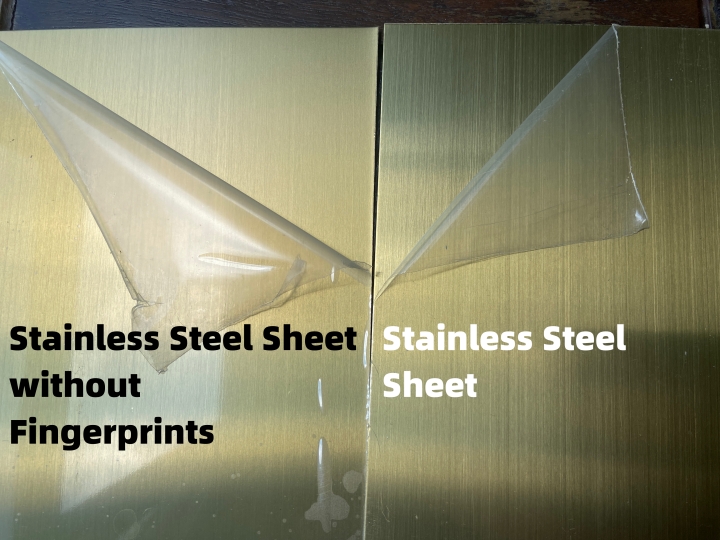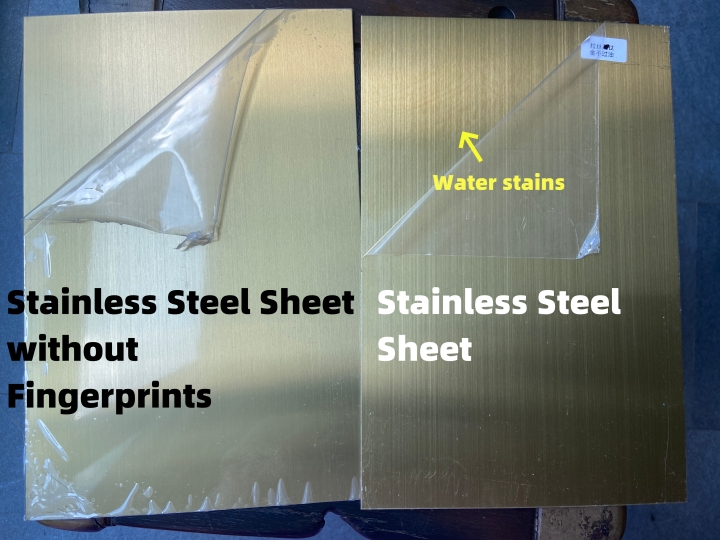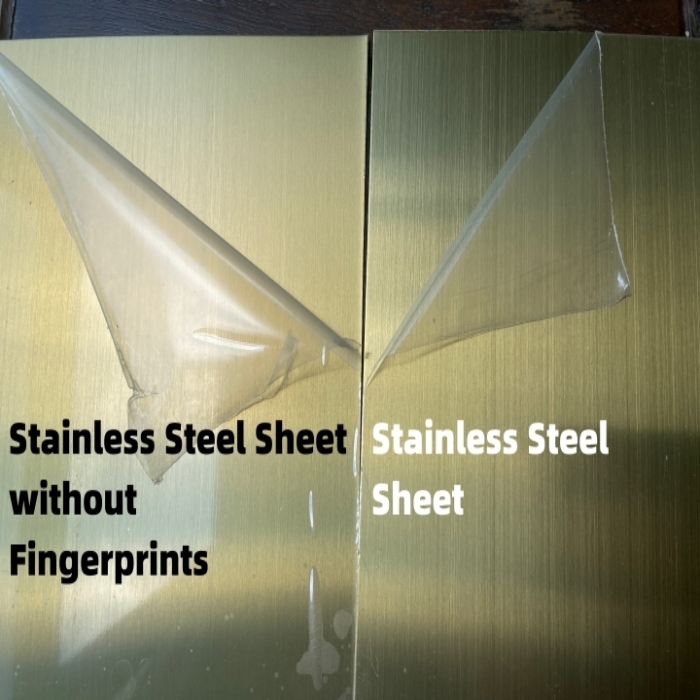Stainless Steel Plate with and without Fingerprints
Comparison of stainless steel plate before and after fingerprint-free treatment
Stainless steel fingerprint-free plate refers to a protective layer of transparent colorless to light yellow liquid coated on the surface of stainless steel. After drying, this transparent nano-metal roller coating liquid is firmly combined with the stainless steel surface of various textures to form a transparent, hard and solid protective film layer. The surface of stainless steel is processed with advanced fingerprint-free technology to increase the beauty and durability of metal decorative plates. Its main purpose is to prevent people from leaving fingerprints on the surface when touching these plates, and to prevent the surface from losing its luster and turning yellow due to oil, sweat stains, dust and so on.
The PVD special coating liquid on the surface of the transparent film layer without fingerprints has good film properties and high hardness, which can protect the metal surface from scratches. Stainless steel has excellent anti-rust performance without fingerprints. A protective film is formed on the metal surface to effectively prevent the outside from corroding the metal part, greatly extending the service life.
Stainless steel fingerprint-free treatment: Generally, oil treatment is done on the basis of frosted, brushed, and snowflake sand surface processing. The oiling process includes: high-temperature cleaning, oiling, high-temperature drying, and film pasting. After this processing, there will be a layer of transparent film on the surface of the stainless steel. There will be no obvious fingerprints when you touch it with your fingers, so it is called fingerprint-free stainless steel.
How to identify stainless steel with fingerprint-free treatment



We conducted a small experiment on two PVD golden brushed stainless steel plates by pressing fingerprints and wiping them with a wet towel. The key difference between these two plates is that one has an oil seal for a fingerprint-free effect, while the other does not. When pressing fingerprints on both plates, the regular stainless steel plate showed visible fingerprints, whereas the oil-sealed fingerprint-free stainless steel plate did not (see image 2). In the second test, we wiped both plates with a wet cloth. The regular stainless steel plate showed water marks, while the fingerprint-free stainless steel plate remained spotless (see image 3). Although the regular stainless steel plate shows signs of use, it has a more pronounced metallic texture compared to the fingerprint-resistant stainless steel plate.
Once fingerprints are left on the stainless steel surface, it is easy to attract more dust and make the surface lose its luster. Over time, it is also easy for the stainless steel surface to lose a layer of metal plating. So, products using fingerprint-free technology are not only beautiful, but also more durable than ordinary metal plating. They can maintain the glossy surface when they were just purchased, and they are always new. This prolongs the service life of the metalworks and reduces the time for daily maintenance. There is no need to wipe it after use like ordinary surfaces.
Do you need to choose stainless steel with fingerprint-free treatment?
While fingerprint-free stainless steel offers numerous advantages such as prolonged gloss and reduced maintenance, it also comes with limitations. For instance, it cannot be easily welded or stretched. Exposure to high temperatures can cause discoloration, detracting from its aesthetic appeal. Hence, construction involving these materials should be conducted away from heat sources to maintain their visual integrity.
In summary, fingerprint-free stainless steel not only enhances the appearance of metalworks but also provides practical benefits through increased durability and reduced maintenance. These characteristics make it an ideal choice for applications where both aesthetics and longevity are paramount.
